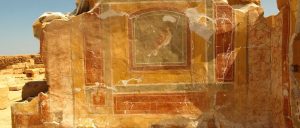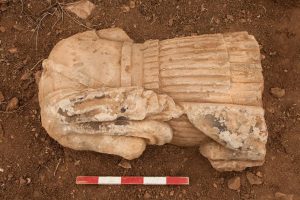After the civil war turmoil ended archaeologists returned to Ptolemais in Libya, an ancient Roman trading port. New discoveries were made at the site, including a hoard of silver and bronze coins and a vast villa covered with elaborate mosaics.

Archaeologists have unearthed statues, elaborate mosaics and other treasures in a 1700-year-old villa dated to 3rd century AD. The building was built around a courtyard in classic Roman peristyle arrangement. It covers an area of around 600 square metres. The artwork depicts a sleeping Dionysus and Ariadne – a daughter of King Minos. Another mosaic depicts the Achillean cycle representing Achilles on the island of Skyros – where his mother, fearful that he would meet his death at Troy, dressed him as a girl to avoid military recruiters. The villa walls bore colourful frescos, imitating marble revetments with geometric designs. Several walls are covered with figural paintings, mainly depicting various species of birds.

The ancient city was established at the turn of the 4th century BC at the Libyan cost of North Africa. Although its original name is not known, it was named “Ptolemais” during the reign of the Ptolemaic empire over Egypt. In 96 BC the entire province of Cyrenaica, including Ptolemais, was handed over to the Romans peacefully by the ruler of the Ptolemaic dynasty. However soon the province deteriorated into a pirate’s nest and order was restored in 1st century AD, followed by Romanisation of the population. The house is believed to have been destroyed in a series of earthquakes in the mid 3rd and 4th century AD. Ptolemais survived and remained the capital of Cyrenaica until the year 428 AD when it was destroyed by the Vandals, who invaded North Africa, was rebuilt under reign of the Byzantine emperor Justinian I and existed until 7th century when was razed by the Arab forces.

Within the building’s destruction layers a hoard of 553 sestercii – silver and bronze coins hailing back to Republican times were found Most of the coins were found inside a room inside the house where terracotta lamps were manufactured. According to archaeologists, the coins may have been the earnings of local craftsmen.

(after Haaretz & Miron Bogacki)